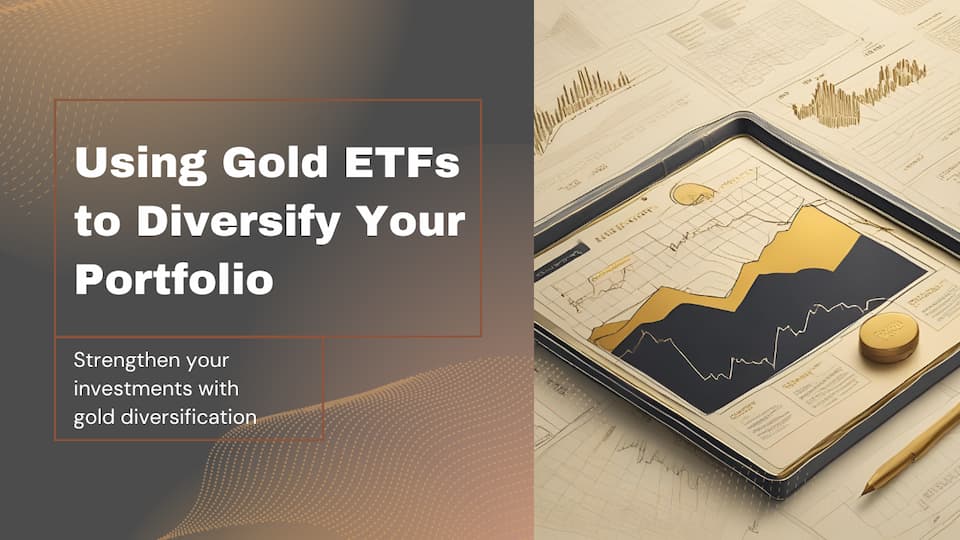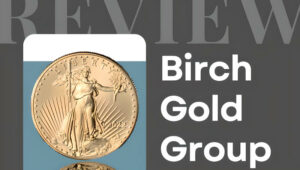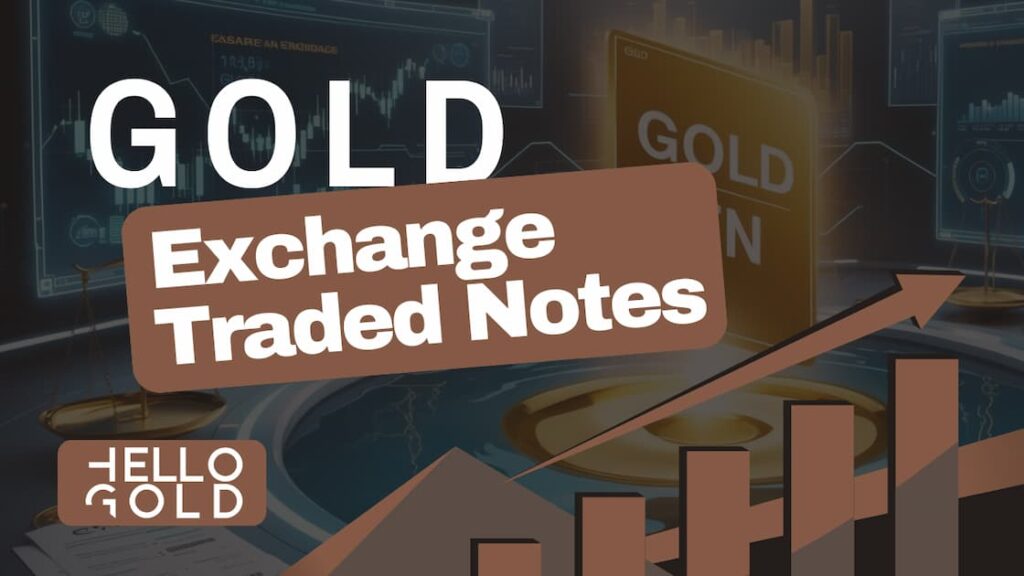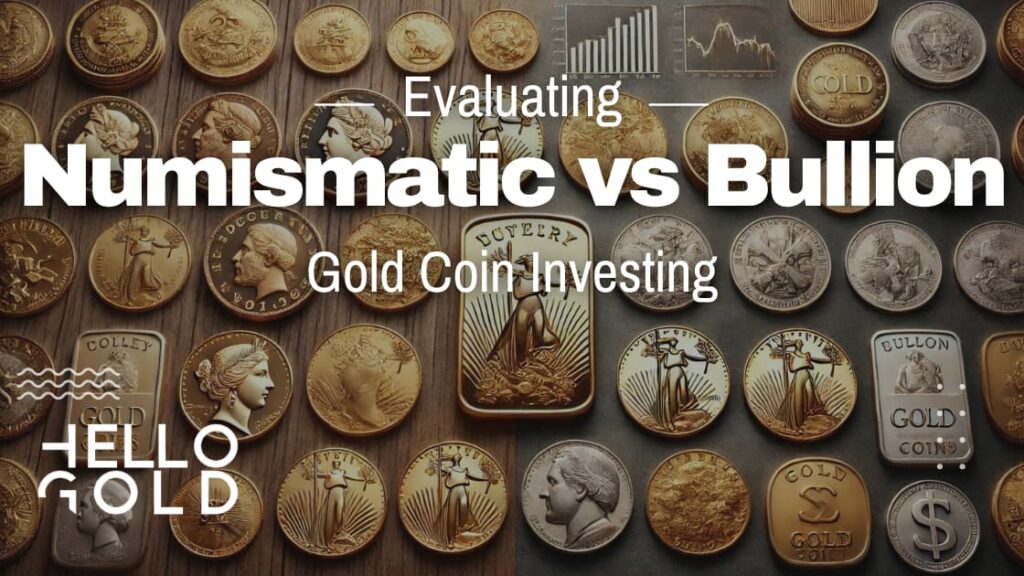Want to strengthen your investments and protect your financial future? Gold ETFs could be the answer. Learn how these easy investment options let you benefit from changes in gold prices without owning it yourself.
In this article, we’ll talk about different Gold ETF types, their advantages, and adding them into your investment plan.
Don’t miss the chance to add stability and possible gains to your portfolio – explore the world of Gold ETFs with us!
Understanding Gold ETFs
As an investor looking to make your portfolio more diverse, you’ve probably heard about the possible benefits of adding gold to your investments.
But how can you get exposure to this precious metal without the trouble of actually owning and storing it?
Enter Gold ETFs.
What Is a Gold ETF?
A Gold ETF, or Exchange-Traded Fund, is an easy investment option that lets you take part in the price changes of gold without needing to directly own it. Think of it as a way to invest in gold without worrying about protecting bullion or dealing with buying and selling actual gold.
Here’s how it works: Gold ETFs are traded on stock exchanges, just like normal stocks.
You can buy and sell shares of these ETFs through your brokerage account, making it simple to add to your investment portfolio.
When you buy shares of a Gold ETF, you’re basically buying a piece of the total value of gold held by that fund.
As the market price of gold goes up and down, the value of your ETF shares will follow along.
Now, you might be wondering, ‘What’s the difference between owning a Gold ETF and holding real gold?’ Good question.
While both give you exposure to the precious metal, there are some key differences.
With actual gold, you’re in charge of storage, security, and insurance, which can be expensive and difficult.
Gold ETFs, on the other hand, remove those hassles. They offer a more cost-effective and liquid method for gaining gold exposure, letting you easily buy and sell shares when needed.
Types of Gold ETFs
Not all Gold ETFs are the same. There are several types available, each with its own structure and investment method. Let’s break them down:
Bullion-backed ETFs: These are the most straightforward choice. Funds like SPDR Gold Shares (GLD) and iShares Gold Trust (IAU) hold real gold in secure vaults.
When you invest in these ETFs, you’re getting direct exposure to the actual asset – gold itself. They tend to have low expense ratios and closely track the spot price of gold, making them a popular pick for those looking for pure gold exposure without the problems of ownership.
Futures-based ETFs: Instead of holding actual gold, these ETFs invest in gold futures contracts. By buying and selling these contracts, they try to copy the price movements of gold. Examples include ProShares Ultra Gold (UGL) and DB Gold Double Long ETN (DGP).
While they can offer bigger returns, these ETFs also come with higher risks and complexities, like the need to roll over contracts every so often.
Mining Company ETFs: Rather than investing directly in gold, these ETFs hold a basket of stocks from companies involved in gold mining and production.
VanEck Vectors Gold Miners ETF (GDX) and VanEck Vectors Junior Gold Miners ETF (GDXJ) are two popular options in this group.
Their performance depends not just on gold prices but also on how well the underlying mining companies are operating. So, you’re getting indirect exposure to gold, with the chance for higher returns but also extra company-specific risks.
Each type of Gold ETF has its upsides and downsides to think about.
Bullion-backed ETFs provide simplicity and a direct link with gold prices, but they do have storage costs that can slightly lower your returns over time.
Futures-based ETFs can give bigger gains in a bullish gold market, but they’re also more complex and carry higher risks.
Mining company ETFs give indirect exposure to gold while introducing company-specific risks that could impact your investment.
The Benefits of Diversifying with Gold ETFs
Let’s face it, investing can be a rollercoaster ride. Market volatility can leave you feeling like you’re on a never-ending loop of ups and downs.
But what if I told you there’s a way to smooth out those twists and turns?
That’s where Gold ETFs come in – they offer a unique opportunity to diversify your portfolio and add some much-needed stability to your investments.
Improving Portfolio Stability
One of the key advantages of Gold ETFs is their ability to improve portfolio stability.
You see, gold has a low correlation with other major asset classes like stocks and bonds. In plain English, that means gold prices don’t move in tandem with the stock or bond markets.
When stocks take a nosedive during economic crises or geopolitical tensions, gold often holds its ground or even appreciates in value.
Let’s look at the 2008 financial crisis as an example. While global stock markets experienced significant declines, gold prices rose by around 25% over the same period.
It’s like having an emergency parachute for your investments – when everything else is falling, gold can help cushion the blow and keep your portfolio afloat.
Hedging Against Inflation
Inflation can be a real wealth killer, quietly eroding the purchasing power of your hard-earned money over time. But here’s the good news: gold has a reputation as a reliable inflation hedge, and Gold ETFs allow you to leverage this characteristic with ease.
During inflationary periods, the value of cash and cash-equivalent assets tends to decline.
Gold, on the other hand, typically appreciates, preserving the real value of your investments. Just look at the high inflation period of the 1970s – gold prices skyrocketed from around $35 per ounce at the beginning of the decade to over $850 per ounce by 1980.
By including Gold ETFs in your portfolio, you’re essentially adding an insurance policy against inflation. When prices start to rise, your Gold ETF holdings can help offset the impact on your overall wealth, ensuring that your money maintains its purchasing power.
Enhancing Portfolio Liquidity
Let’s be honest, having the flexibility to adjust your investments as needed is crucial in today’s ever-changing market landscape. This is where Gold ETFs excel – they offer unparalleled liquidity compared to physical gold or other less liquid investments.
Unlike owning physical gold, which can be a hassle to buy and sell (not to mention the added costs of storage and insurance), Gold ETFs trade on major stock exchanges. This means you can easily buy or sell shares throughout the trading day at market prices, giving you the freedom to adapt your gold exposure based on changing market conditions or your personal financial goals.
Constructing a Diversified Portfolio with Gold ETFs
Now that we’ve covered the basics of Gold ETFs and how they can benefit your portfolio, let’s talk about actually adding them into your investment plan. Building a diverse portfolio is key to long-term success, and Gold ETFs can play an important role in achieving that.
Determining Your Ideal Allocation
The first step is figuring out how much of your portfolio should be given to Gold ETFs. This isn’t a one-size-fits-all choice – it depends on your age, risk tolerance, and overall investment goals.
Let’s break it down:
Age: If you’re younger, you might want to focus more on growth investments and give a smaller percentage to Gold ETFs. But if you’re closer to retirement, a higher allocation could provide some much-needed stability during market ups and downs.
Risk Tolerance: Are you comfortable with a bit of risk, or do you prefer a more conservative approach?
If you don’t like risk, a larger allocation to Gold ETFs can help reduce the impact of market swings. But if you’re willing to take on more risk for potentially higher returns, you might choose a smaller allocation.
Investment Goals:
What are you trying to achieve with your investments? If you’re looking for steady income, Gold ETFs might play a smaller role. But if you want long-term growth with protection against inflation, a more substantial allocation could be helpful.
You might be wondering, “Okay, but what’s the perfect number?”
Well, investment professionals often recommend allocating between 2% and 10% of your portfolio to gold.
But remember, everyone’s situation is different, so it’s always a good idea to use tools like asset allocation calculators or speak with a financial advisor to determine a personalized allocation that fits your needs.
Implementing a Rebalancing Strategy
Once you’ve determined your ideal allocation, it’s important to put into place a rebalancing plan to ensure your portfolio stays on track. Rebalancing is the process of periodically buying or selling assets to maintain your target allocation.
Here’s an example: Let’s say your target allocation for Gold ETFs is 5%, but after a market rally, it’s grown to 7%. To rebalance, you’d sell some of your Gold ETF holdings to bring that allocation back down to 5%.
Rebalancing helps manage risk and ensures your portfolio stays diverse. It prevents any one asset class from taking over your portfolio and keeps you aligned with your investment goals.
So, how do you go about rebalancing your Gold ETF holdings? Follow these steps:
- Review your current allocation: Check the proportion of your investments currently held in Gold ETFs and compare it to your target allocation.
- Identify overweight or underweight assets: If Gold ETFs are overweight, you’ll need to sell some shares. If they’re underweight, you might want to buy more.
- Make transactions: Use your brokerage account to buy or sell Gold ETF shares as needed.
- Document your changes: Keep a record of your transactions and the reasoning behind them. This will help you track your strategy’s effectiveness and guide future adjustments.
Now, when it comes to setting rebalancing limits and frequency, there are a few approaches you can take.
Some investors rebalance based on a specific time period, like quarterly or annually.
Others rebalance when an asset class moves away from its target allocation by a certain percentage, say 2% or 5%.
Whichever approach you choose, the key is to stick to a steady rebalancing schedule. This will help ensure your portfolio stays aligned with your risk tolerance and investment goals over time.
And remember, while rebalancing is an important part of portfolio management, it’s not a set-it-and-forget-it plan. As your financial situation changes, you may need to revisit your asset allocation and make adjustments accordingly.
Navigating the Risks of Gold ETF Investing
You’ve probably heard the old investing saying: “It’s a marathon, not a sprint.”
And when it comes to gold ETFs, this wisdom is very true. While the price of gold can change in the short-term, it’s crucial to keep a long-term view and not get caught up in every market swing.
Understanding Market Volatility
When investing, short-term volatility is a natural part of the journey. However, it’s the long-term path that truly matters.
Like an experienced captain focusing on the horizon rather than the choppy waters, you should keep your attention on your long-term investment goals.
So, how can you navigate these rough waters?
One effective strategy is dollar-cost averaging, which involves investing a fixed amount of money at regular intervals, no matter the price.
By doing so, you’ll avoid the temptation to make impulsive decisions based on short-term market changes, and you’ll be better positioned to ride out the waves and take advantage of gold’s long-term potential.
Considering Opportunity Costs
By investing in gold ETFs, you’re essentially choosing to allocate part of your portfolio to an asset that doesn’t generate income or dividends, unlike stocks or bonds. However, this doesn’t mean that gold is a suboptimal investment – it simply means that you need to weigh the trade-offs carefully.
Think of it this way – during times of economic uncertainty or crisis, gold has historically served as a safe asset, providing stability and preserving wealth when other investments falter. In fact, during the inflationary turmoil of the 1970s, the price of gold skyrocketed from a modest $35 per ounce in the early years of the decade to surpass $800 per ounce by 1980, showcasing its potential for significant growth during challenging times.
While stocks have generally outperformed gold over multiple decades, there have been times when the precious metal has outshone traditional investments. The key is striking a balance – by carefully considering opportunity costs and maintaining a well-diversified portfolio, you can leverage the unique benefits of gold ETFs while still taking advantage of the growth potential of other assets.
Getting Started with Gold ETF Investing
Ready to add gold to your portfolio?
Don’t worry, the process is simpler than you might think.
Let’s break down how to get started with Gold ETFs, from picking the right fund to making your first trade.
Choosing the Right Gold ETF
The first step to investing in gold ETFs is picking the right one for your portfolio. With various options available, it’s key to think about several factors to make sure your choice matches your investment goals and risk tolerance.
Start by looking at the expense ratio, the yearly fee charged by the ETF for its operations. A lower expense ratio directly means higher net returns over time.
For example, popular options like iShares Gold Trust (IAU) have a 0.25% expense ratio, while SPDR Gold Shares (GLD) charges a slightly higher 0.40%. These small differences can greatly impact your long-term gains.
Next, review the ETF’s tracking error, which measures how closely its price movements reflect the actual price of gold. A lower tracking error indicates a more precise reflection of gold’s performance, ideal for investors seeking direct investment in the precious metal.
Consider the assets under management (AUM), a key sign of the ETF’s stability and liquidity. Higher AUM typically signals strong investor confidence and a more liquid market, making it easier to buy and sell shares without causing big price changes.
Remember, not all gold ETFs are the same. Bullion-backed ETFs, like those physically holding gold bars and coins such as GLD and IAU, offer a direct link to its price, providing a classic protection against inflation.
Alternatively, mining company ETFs like the prominent GDX fund invest in gold mining companies, offering the potential for greater profits but also carrying company-specific risks. Align your choice with your investment goals, whether it’s pure gold exposure or leveraging the growth potential of the mining industry.
Opening and Funding a Brokerage Account
With your ideal Gold ETF in mind, the next step is to open a brokerage account. This is your gateway to buying and selling ETF shares.
Start by researching different brokerage platforms. Look into factors like commission fees, account maintenance costs, research tools, and customer service.
Popular options include well-established firms like Fidelity and Charles Schwab, as well as newer platforms like Robinhood and Interactive Brokers. Each offers unique features, so choose one that aligns with your needs and preferences.
Next, decide on the type of brokerage account that suits your financial goals.
If flexibility and quick access to funds are important, an individual brokerage account might be the best choice.
However, be aware that any gains or losses will be subject to taxes.
For those focused on long-term investing, particularly for retirement, an Individual Retirement Account (IRA) could be a more helpful option. IRAs offer tax benefits, either through tax-deferred growth or tax-free withdrawals, depending on whether you choose a traditional or Roth IRA.
If you’re investing with a partner, consider a joint brokerage account for shared ownership and simplified management of your combined investments.
Parents or guardians looking to invest on behalf of a child can opt for a custodial account. This allows you to manage investments until the child reaches adulthood, potentially providing a head start on saving for education or other future needs.
Once you’ve chosen your preferred platform and account type, follow the instructions to open your account. Typically, this involves providing personal information, completing an application, and waiting for approval.
With your account approved and ready to go, it’s time to fund it.
Most platforms allow you to link your bank account, enabling easy transfers or recurring deposits.
Start by depositing an amount that aligns with your current budget and future investment plans.
Now comes the exciting part: placing your first Gold ETF trade.
Use the platform’s search function to find your chosen ETF’s ticker symbol.
Select the “Trade” option, choose your desired order type (market order for immediate execution or limit order for a specified price), and carefully review the order details before confirming your trade.
Congratulations! You’ve successfully entered the world of Gold ETF investing!
In Summary
Gold ETFs present a valuable chance to improve your investment portfolio, providing diversification, stability, and potential protection against inflation.
With choices like bullion-backed, futures-based, and mining company ETFs, you can pick the one that lines up with your investment goals and risk tolerance.
To start, choose the right Gold ETF, set up and fund a brokerage account, and make your first trade. Adding Gold ETFs into your portfolio and keeping a long-term outlook will allow you to navigate market changes and take advantage of gold’s unique benefits as an alternative investment.
Start looking into Gold ETFs today and unlock the potential of this non-traditional investment for your financial future.











